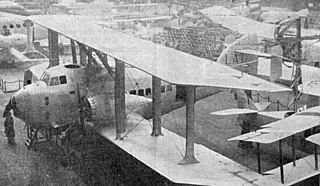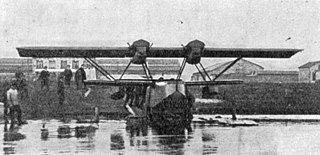The Donnet-Denhaut flying boat was a maritime patrol and anti-submarine warfare aircraft produced in France during the First World War. Known at the time simply as "Donnet-Denhaut" or "DD" flying boats, the DD-2, DD-8, DD-9, and DD-10 designations were applied retrospectively to denote the various changes in configuration made during their service life.

The Latham 43 was a flying boat bomber built in France in the 1920s for service with the French Navy. It was a conventional design for its day - a two-bay biplane with unstaggered wings, and engines mounted tractor-fashion on struts in the interplane gap. The pilot sat in an open cockpit, with a gunner in an open bow position, and another in an open position amidships.

The Latécoère 4 was a three-engined, 15-passenger biplane built in France in the early 1920s. It proved difficult to fly and was discontinued, though a second machine was completed as the Latécoère 5 bomber.
The Sopwith Admiralty Types 137 and 138 were a pair of single-engine, two-seat naval biplane floatplanes, built to a British Admiralty order in 1914. They were similar in design, but having a more powerful engine the Type 138 was the larger and heavier. They were used in early torpedo dropping experiments in 1914.
The Sopwith Special torpedo seaplane Type C was the first British aircraft designed to drop torpedoes. A single-engine biplane floatplane, it flew in July 1914 but proved unable to lift the design load and was soon abandoned.

The Hanriot H.31 was a single engine, single seat French biplane fighter aircraft built in 1925 to compete in a government programme. It was not successful and only one prototype was completed.

The Caudron C.43 was the first French five-engined aircraft, a biplane intended for passenger transport or military use and multi-engined for safety. A development of the three-engined Caudron C.39, it had one tractor configuration engine in the nose and two push-pull pairs between the wings. It was capable of carrying eight passengers but was not developed.

The Caudron C.39 was a French three-engined biplane with a cabin for six passengers when the aircraft was equipped as a landplane or four passengers when on floats. It was flown with some success in competitions in 1920 and 1921.

The Caudron C.25 was a large, three-engined, biplane airliner, designed and built in France soon after the end of World War I. Its enclosed cabin could accommodate up to eighteen passengers.
The Caudron Type C was a single seat French biplane, intended for military evaluation. Two were built in 1911.
The Latham E-5 was a large French Naval four engine biplane flying boat, flown in 1925. It was successfully tested but only one was built.
The Latham Trimotor was a large French trimotor biplane built just after World War I and used in small numbers by the French Navy.

The Amiot 110-S was an all-metal, amphibious military flying boat built in France in the 1930s. It was intended as a maritime reconnaissance and medium bomber aircraft but only two were built.

The CAMS 110 was a French twin engine biplane flying boat built to fill a range of maritime military rôles including long range reconnaissance, bombing and general exploration. it was not selected for production and only one was built.
The Latham L.1 was a French competitor in the 1923 Schneider Trophy race. It was a twin engine, biplane flying boat, built by Société Latham.
The Caproni Ca.61 was an Italian heavy day bomber aircraft of 1922. It was the final development of the Caproni three engine, twin boom biplane types developed during World War I, but it was not put into production.

The Hanriot H.38 was a French twin-engined sesquiplane flying boat built in the mid-1920s. Though the sole prototype was fitted with two defensive machine gun posts. the H.38 was described at the time as a utility aircraft.

The Lioré et Olivier Leo H-15 was a French twelve-seat civil flying boat, flown in a national contest in 1926. It did not win but set two load carrying records, one a world record.

The Denhaut Hy.479 was a French flying boat flown in 1926 and intended to be suitable for commercial or military applications. Only one, in military configuration, was built and was sometimes known as the France-Aviation Denhaut.

The CAMS 54 was a strengthened and more powerful version of the French CAMS 51 civil transport and naval reconnaissance flying boat, developed for transatlantic flights. It is sometimes referred to as the 54 GR.













